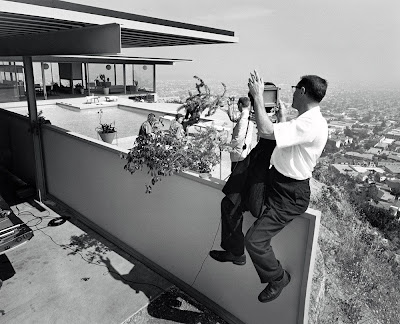

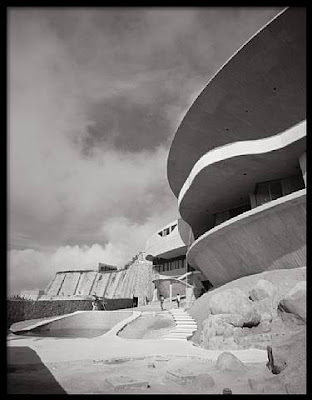

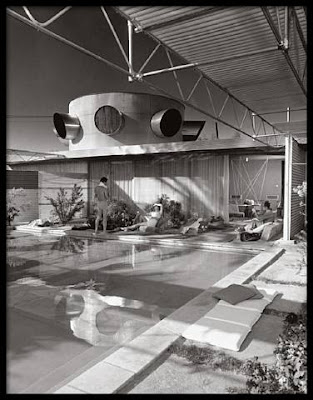
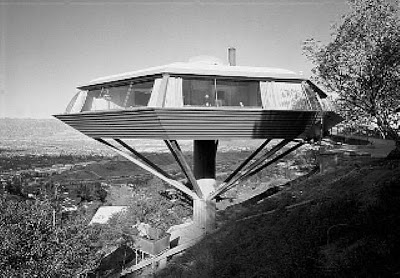
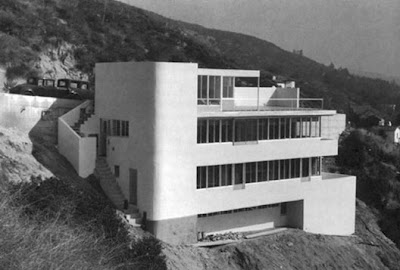


Julius Shulman, who turned photographs of Modernist buildings into works of art, died July 15 at his home in the Hollywood Hills of Los Angeles. He was 98, and no specific cause of death was reported.
Mr. Shulman's most famous work was a black-and-white photo taken of a glass and steel frame home built by architect Pierre Koenig in the Hollywood Hills above Laurel Canyon Boulevard as the sun was setting May 9, 1960. It was No. 22 in John Entenza's Arts & Architecture magazine's Case Study housing program.
The picture from outside the cantilevered house was shot through its glass walls toward a sea of sparkling city lights below. Two women seem to be chatting in the living room, and the horizontal pattern of the ceiling above them extends outside to the house's overhang. It was a lifestyle statement that made Shulman's career.
It was also a last-minute job for the photographer known as "One-Shot Shulman" because he never used a light meter and seldom had to take more than one shot.
For No. 22, though, he took two photos at once -- one of the view below with a 7 1/2 -minute time exposure and a 4-by-5 camera, and the other of the house, with a flash. Critics hailed it as a photo that was both time specific and timeless.
"He may not have considered himself an artist, but his work has been reviewed in all the important art magazines of the day," said Santa Monica, Calif., gallery owner Craig Krull, who has represented Shulman for 20 years.
He, in my opinion and the opinions of many, is the most important architectural photographer in history," Krull said. "He elevated what you might consider a commercial genre to a fine art."
The Getty Center bought Mr. Shulman's archive of 260,000 photos in 1995. At the time of the announcement, Arthur Ollman, director of the Museum of Photographic Arts in San Diego, called Shulman "the king of California architecture photography."
"Nobody did it better than Shulman, and likely nobody will," he said.
Mr. Shulman then teamed up with collaborator Juergen Nogai and worked into his 90s to build another library of photos.
His pictures at one time sold for less than $50 each, but in later years would bring between $2,000 and $20,000.
When asked how Mr. Shulman's photos of houses differed from others, Krull said: "Modernism is characterized by an optimistic spirit, a belief that the future holds great promise and technology will improve civilization. Julius was perfectly suited to translate the tenets of optimism."
Julius Shulman was born Oct. 10, 1910, in Brooklyn, N.Y., and grew up on a farm in Connecticut, where he said he developed a love of nature and learned about light and shadows.
When he was 10, his family moved to Los Angeles and opened a dry-goods store. His father died of tuberculosis in 1923, leaving his mother with five children and the business.
Mr. Shulman took a photography class in high school, his only training in the field. He spent the next several years earning his rent money by taking photos with an Eastman Kodak box camera. One picture of a bridge won first place in a national magazine contest.
It was a casual meeting with architect Richard Neutra in 1936 that launched his career.
Over the years, his other renowned architectural clients included Frank Lloyd Wright, Rudolf M. Schindler, Gregory Ain, Charles Eames, Raphael S. Soriano, John Lautner and Eero Saarinen. Mr. Shulman's Hollywood Hills house, designed by Soriano, was recognized as an official landmark in 1987 by the Los Angeles Cultural Heritage Commission as the architect's only remaining unaltered steel-frame structure.
